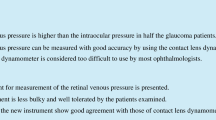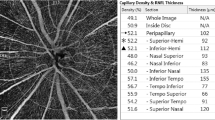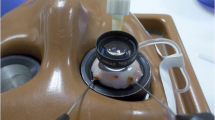Abstract
Purpose
The purpose was to measure the blood flow velocity during the suction phase of LASIK.
Setting
University Eye Hospital, Martin-Luther-University Halle-Wittenberg, Halle, Germany.
Methods
Papillary blood flow velocity was measured by colour Doppler sonography. Suction rings of four different manufacturers were applied in 30 healthy volunteers without eye diseases all of normal blood and eye pressure. The velocity of the blood flow in the central retinal artery was measured before, during and after suction.
Results
When Hansatome (Bausch & Lomb) and M2 (Moria) rings were used, no blood flow velocity was detected during suction in 90% of all cases. These rings were compared to the SKBM standard suction ring (Alcon) and the Krumeich non-IOP ring, in which no blood was present in only 56.67% (p < 0.05) and 10% (p < 0.001) of cases respectively. Moria, Alcon and Krumeich Lasitome rings performed equally well during the recovery phase compared with the original values. An exception is the Hansatome ring (Bausch & Lomb), with lower velocities when evaluated after 30 minutes (p < 0.01).
Conclusions
During the ring suction phase of LASIK, the rings tested reduce velocity differently.


Similar content being viewed by others
Abbreviations
- ACR syst.:
-
Arteria centralis retinae systolic blood flow
- ACR dias.:
-
Arteria centralis retinae diastolic blood flow
- VCR:
-
Vena centralis retinae
- B&L:
-
Bausch and Lomb
- SKBM:
-
Summit Krumeich Barraquer Microkeratome
- M2:
-
Mikrokeratome designation of M2-Evolution 2 by Moria
- non-IOP:
-
non-intraocular pressure
References
Ahmadieh H, Javadi M (2005) Cilioretinal artery occlusion following laser in situ keratomileusis. Retina 24(4):533–537
Bissen-Miyajima H, Suzuki S, Ohashi Y, Minami K (2005) Experimental observation of intraocular pressure changes during microkeratome suctioning in laser in situ keratomileusis. J Cataract Refract Surg 31(3):590–594 Mar
Cameron B, Saffra N, Strominger M (2001) Laser in situ keratomileusis-induced optic neuropathy. Ophthalmology 108(4):660–665 Apr
Delorme S, Debus J (1998) Ultraschalldiagnostik. Hippokrates Verlag, Stuttgart
Ellies P, Pietrini D, Lumbroso L et al (2000) Macular hemorrhage after laser in situ keratomileusis for high myopia. J Cataract Refract Surg 26(6):922–924 Jun
Harris A, Drance S (1997) Sehnerv und Durchblutung. Sonderdruck Chibret AG, Opfikon-Glattbrugg
Iester M, Tizte P, Mermoud A (2002) Retinal nerve fiber thickness changes after an acute increase in intraocular pressure. J Cataract Refract Surg 28(12):2117–2122 Dec
Kaiser H (1996) Abklärung von Sehstörungen mit der Farbduplexsonographie. Ther Umsch 53(1):43–48
Lee A, Kohnen T, Ebner R et al (2000) Optic neuropathy associated with laser in situ keratomileusis. J Catract Refract Surg 26(11):1581–1584
Lieb W, Meyer G (1998) Farbduplexsonographie in der Augenheilkunde. Ultraschall Klinische Praxis 11:76–79
Loewenstein A, Lipshitz I, Varssano D et al (1997) Macular hemorrhage after laser photorefractive keratectomy. J Cataract Refract Surg 23(5):808–810 Jun
Mawn L, Hedges T, Rand W (1997) Orbital color doppler imaging in carotid occlusive disease. Arch Ophthalmology 115:492–496
Meyer C, Mostafavi R (2002) Erhöhtes Ablatio-Risiko nicht ausgeschlossen. Ophth Nachrichten 3:23
Mirshahi A, Schöpfer D, Gerhardt D et al (2006) Incidence of posterior vitreous detachment after laser in situ keratomileusis. Graefes Arch Clin Exp Ophthalmol 244(2):149–153
Mirshahi A, Kohnen T (2005) Effect of microkeratome suction during LASIK on ocular structures. Ophthalmology 112(4):645–649 Apr
Ozdamar A, Kücüksümer Y, Aras C, Akova N, Ustundag C (2004) Visual field changes after laser in situ keratomileusis in myopic eyes. J Cataract Refract Surg 30(5):1020–1023
Ozdamar A, Ocakoglu O (2003) Optic nerve head blood flow using scanning laser Doppler flowmetry after laser in situ keratomileusis. J Refract Surg 19(4):433–437
Ruiz-Moreno J, Alió J (2003) Incidence of retinal disease following refractive surgery in 9,239 eyes. J Refract Surg 19(5):534–547
Ruiz-Moreno J, Pérez-Santonja J, Alió J (1999) Retinal detachment in myopic eyes after laser in situ keratomileusis. Am J Ophthalmol 128(5):588–594
Schüttauf F (1999) Duplexsonographische Untersuchungen zur retinalen Durchblutung nach Inhalation verschiedener Atemgasgemische. Promotion, Martin-Luther-Universität Halle-Wittenberg
Sharma N, Pangtey M, Dada V (2002) LASIK-induced optic neuropathy. Ophthalmology 109(5):819
Tabbara K, El-Sheikh H, Vera-Cristo C (2003) Complications of laser in situ keratomileusis (LASIK). Eur J Ophthalmol 13(2):139–146
Yang B, Wang Z, Huang G et al (2003) Transient macular edema after laser in-situ keratomileusis. Yan Ke Xue Bao 19(1):20–24
Author information
Authors and Affiliations
Corresponding author
Additional information
No author has a financial or proprietary interest in any material or method mentioned.
Rights and permissions
About this article
Cite this article
Schicke, S.H., Krumeich, J., Duncker, G.I.W. et al. Retinal colour duplex scanning during LASIK-ring suction with different keratomes. Graefes Arch Clin Exp Ophthalmol 246, 1009–1015 (2008). https://doi.org/10.1007/s00417-008-0796-5
Received:
Revised:
Accepted:
Published:
Issue Date:
DOI: https://doi.org/10.1007/s00417-008-0796-5




